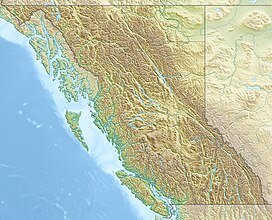geo.wikisort.org - Mountains
Caribou Tuya is a basaltic subglacial mound in far northwestern British Columbia that began eruptive activity under glacial ice during the Fraser glaciation (25 to 10 ka). Like Ash Mountain and South Tuya, sections of the subglacial mound reveal a consistent stratigraphic progression from pillow lavas to hyaloclastite deposits from the base upward. Locally the sections are capped by subaerial basaltic lava flows. Samples of the glassy pillow basalts and hyaloclastites along with crystalline basalt flows were collected at Caribou Tuya. The volcano is believed to have formed and last erupted during the Pleistocene Epoch.[1]
| Caribou Tuya | |
|---|---|
| Highest point | |
| Elevation | 1,770 m (5,810 ft) |
| Coordinates | 59°14′11″N 130°33′45″W |
| Geography | |
| Location | British Columbia, Canada |
| District | Cassiar Land District |
| Parent range | Tuya Range |
| Topo map | NTS 104O2 Tuya Lake |
| Geology | |
| Mountain type | Subglacial mound |
| Volcanic arc/belt | Northern Cordilleran Volcanic Province |
| Last eruption | Pleistocene |
See also
- List of volcanoes in Canada
- List of Northern Cordilleran volcanoes
- Volcanism of Canada
- Volcanism of Western Canada
- Volcanic history of the Northern Cordilleran Volcanic Province
References
- "Caribou Tuya". Catalogue of Canadian volcanoes. Archived from the original on 2011-06-04.
Текст в блоке "Читать" взят с сайта "Википедия" и доступен по лицензии Creative Commons Attribution-ShareAlike; в отдельных случаях могут действовать дополнительные условия.
Другой контент может иметь иную лицензию. Перед использованием материалов сайта WikiSort.org внимательно изучите правила лицензирования конкретных элементов наполнения сайта.
Другой контент может иметь иную лицензию. Перед использованием материалов сайта WikiSort.org внимательно изучите правила лицензирования конкретных элементов наполнения сайта.
2019-2025
WikiSort.org - проект по пересортировке и дополнению контента Википедии
WikiSort.org - проект по пересортировке и дополнению контента Википедии
